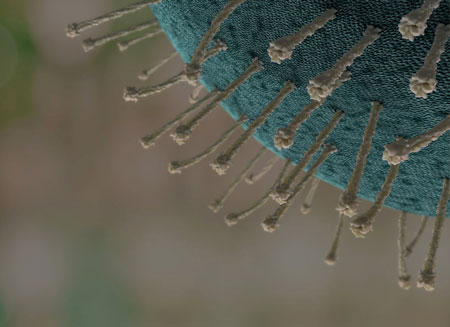| Nov 12, 2012 |
How bacteria attack their host cells with sticky lollipops
|
|
(Nanowerk News) Yersinia enterocolitica, a pathogenic bacterium, causes fever and diarrhea. By help of a protein anchored in its membrane, Yersinia attaches to its host cells and infects them. Scientists of the Max Planck Institute for Developmental Biology in Tübingen and the Leibniz-Institut fuer Molekulare Pharmakologie in Berlin have determined the structure of an important component of the membrane protein and have gained insight into its biogenesis. The membrane proteins provide an interesting starting point for the development of new antibiotics against pathogens.
|
 |
| Bacterial surface with adhesins, sticky lollipop structures enabling the bacteria to attach to their host cells. (Image: Barth van Rossum/Leibniz-Institut fuer Molekulare Pharmakologie)
|
|
Several diseases are caused by an infection with Yersinia enterocolitica. In babies the bacteria induce fever and diarrhea, in adolescents and adults they cause inflammations of the small intestine and various forms of inflammatory arthritis. Yersinia can be transmitted to humans directly from animals, especially pigs, if for example meat has not been heated sufficiently. Special membrane proteins of the bacteria, so-called adhesins, do not only look like lollipops, but are also as sticky as the sweets. They enable the bacteria to attach to their host cells and to invade them. The adhesins reach the bacterial surface by a complex autotransport mechanism. In their study the scientists concentrated on the membrane domain of the complex protein that is responsible for the transport of the extracellular domains.
|
| “This study could only be carried out in a true collaboration,” says Dirk Linke from the Max Planck Institute. The study was funded by the ‘Forschungsprogramm Methoden für die Lebenswissenschaften’ of the Baden-Württemberg Stiftung.
|
|
Proteins located in the membrane are often difficult to isolate, purify and crystallize. It is therefore challenging to study them by conventional structure determination methods. The scientists used solid-state nuclear magnetic resonance spectroscopy to gain structural information about the membrane protein domain. “In addition, magnetic resonance spectroscopy provides insight into the transport dynamics,” explains Barth van Rossum from the Leibniz Institute.
|
|
Yersinia belongs to the class of gram-negative bacteria who are bounded by a specially structured outer double membrane. Many more pathogenic bacteria such as salmonella, legionella or the Cholera pathogen are members of this group causing diarrhea, infections of the urinary tract or the pulmonary tract. The scientists assume that, similar to Yersinia, many gram-negative bacteria make use of membrane proteins in the infection process. “However, in human cells this type of membrane protein is not to be found,” says Dirk Linke. Hopes are that the knowledge about the autotransporter proteins will help in the development of new substances to specifically block transport processes at the membrane of pathogenic bacteria. However the scientists state that there is still a long way to go. They will now conduct new experiments to systematically apply changes to the particularly flexible parts of the protein domain in order to reach a deeper understanding of its mechanism.
|
|
Original publications
|
|
Shakeel A. Shahid, Benjamin Bardiaux, Trent Franks, Ludwig Krabben, Michael Habeck, Barth-Jan van Rossum, Dirk Linke: Membrane protein structure determination by solid-state NMR spectroscopy of microcrystals. Nature Methods, 2012; doi: 10.1038/NMETH.2248
|
|
Shakeel A. Shahid, Stefan Markovic, Dirk Linke & Barth-Jan van Rossum: Assignment and secondary structure of the YadA membrane protein by solid-state MAS NMR. Scientific Reports (2012); doi: 10.1038/srep00803
|

